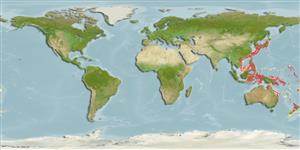Environment: milieu / climate zone / depth range / distribution range
Ecología
marino demersal; rango de profundidad 121 - 271 m (Ref. 11790). Tropical
Western Pacific: Philippines, Japan (Sagami Bay and Kasumi) and the Korean Peninsula.
Tamaño / Peso / Age
Maturity: Lm ? range ? - ? cm
Max length : 29.0 cm TL macho / no sexado; (Ref. 9797)
Espinas dorsales (total) : 0; Radios blandos dorsales (total) : 64 - 68; Espinas anales: 0; Radios blandos anales: 44 - 48; Vértebra: 32. Eyes on left side of body. Conspicuous spot at bases of last rays of dorsal and anal fins. Caudal fin rounded (Ref. 559).
Rare. Minimum depth at 121 m and feeds on bottom-living animals (Ref. 9797).
Life cycle and mating behavior
Madurez | Reproducción | Puesta | Huevos | Fecundidad | Larva
Hensley, D.A., 2001. Citharidae. Largescale flounders. p. 3794-3798. In K.E. Carpenter and V. Niem (eds.) FAO species identification guide for fishery purposes. The living marine resources of the Western Central Pacific. Vol. 6. Bony fishes part 4 (Labridae to Latimeriidae), estuarine crocodiles. FAO, Rome. (Ref. 9797)
IUCN Red List Status (Ref. 130435: Version 2024-2)
Threat to humans
Harmless
Human uses
Pesquerías: sin interés
Herramientas
Special reports
Download XML
Fuentes de Internet
Estimates based on models
Preferred temperature (Ref.
123201): 6.7 - 22.7, mean 17.4 °C (based on 123 cells).
Phylogenetic diversity index (Ref.
82804): PD
50 = 0.6406 [Uniqueness, from 0.5 = low to 2.0 = high].
Bayesian length-weight: a=0.00851 (0.00359 - 0.02015), b=3.06 (2.85 - 3.27), in cm total length, based on LWR estimates for this (Sub)family-body shape (Ref.
93245).
Nivel trófico (Ref.
69278): 3.5 ±0.37 se; based on food items.
Resiliencia (Ref.
120179): Medio, población duplicada en un tiempo mínimo de 1.4-4.4 años (Preliminary K or Fecundity.).
Fishing Vulnerability (Ref.
59153): Low vulnerability (19 of 100).
